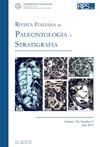THE MIDDLE EOCENE CLIMATIC OPTIMUM (MECO) IMPACT ON THE BENTHIC AND PLANKTIC FORAMINIFERAL RESILIENCE FROM A SHALLOW-WATER SEDIMENTARY RECORD
IF 1.9
3区 地球科学
Q2 GEOLOGY
引用次数: 0
Abstract
We present here new quantitative analyses of planktic and benthic foraminifera to assess the impact of the Middle Eocene Climatic Optimum (MECO, ~40 Ma) on these biotic groups studied along a shallow-water succession rich in larger benthic foraminifera (Sealza, Liguria, NW Italy). The MECO is one of the major Eocene global warming events, characterized by ~4–6°C warming, shifts in the global carbon cycle, and rise in atmospheric pCO2. The Sealza succession is interpreted as the product of a drowning ramp influenced by tectonic activity and provides an exceptional chance to compare biotic variations in shallow-water assemblages with deep-water communities across the MECO. In the section, the MECO interval is tentatively constrained by stable isotope oxygen data and calcareous plankton biostratigraphy. The marked decline in abundance of the epifaunal benthic Cibicidoides across the lower-middle part of the MECO suggests a decrease in oxygenation at the seafloor. Further evidence of oxygen depletion is the increase in organic matter content (TOC) of the sediment and the presence of infaunal genera Uvigerina and Bolivina. The planktic foraminiferal assemblages record the MECO warming in the upper water column as the mixed-layer warm index genera Acarinina and Morozovelloides markedly increase in abundance. In the post-MECO interval, here poorly exposed, cooler conditions are indicated by the dominance of the cold-water index genus Subbotina. Remarkably, Acarinina decline in abundance in the upper MECO interval and never recover. The MECO perturbance permanently impacted the benthic and planktic communities at Sealza that exceeded the tipping point to move to a new regime, thus proving the fauna to be not resilient, but also not recording any extinctions.中始新世气候最适(meco)对浅水沉积记录的底栖和浮游有孔虫恢复力的影响
本文对浮游生物和底栖有孔虫进行了新的定量分析,以评估中始新世气候最适期(MECO, ~40 Ma)对这些生物类群的影响,这些生物类群沿着富含大型底栖有孔虫的浅水演替区(Sealza, Liguria, NW Italy)研究。MECO是始新世主要的全球变暖事件之一,其特征是全球变暖~4 ~ 6°C,全球碳循环发生变化,大气pCO2升高。Sealza演替被解释为受构造活动影响的淹没斜坡的产物,并提供了一个特殊的机会来比较整个MECO浅水组合与深水群落的生物变化。在剖面中,MECO层段暂时受到稳定同位素氧数据和钙质浮游生物地层的约束。脚底下底栖动物Cibicidoides丰度的显著下降表明海底氧化作用的减少。沉积物中有机质含量(TOC)的增加以及水生属Uvigerina和Bolivina的存在是氧气消耗的进一步证据。浮游有孔虫组合记录了上层水柱的MECO变暖,混合层暖指数属Acarinina和Morozovelloides丰度显著增加。在后meco时期,这里暴露不良,温度较低,以冷水指数属Subbotina为主。值得注意的是,Acarinina丰度在MECO上段下降,并且再也没有恢复。MECO的扰动永久性地影响了Sealza的底栖生物和浮游生物群落,这些群落超过了临界点,进入了一个新的状态,从而证明了动物群没有弹性,但也没有记录任何灭绝。
本文章由计算机程序翻译,如有差异,请以英文原文为准。
求助全文
约1分钟内获得全文
求助全文
来源期刊
CiteScore
3.60
自引率
4.30%
发文量
28
审稿时长
>12 weeks
期刊介绍:
The Rivista Italiana di Paleontologia e Stratigrafia was founded in 1895. It publishes original papers dealing with all fields of paleontology and of stratigraphy, from Italy and the Mediterranean to the Tethys, as well across the globe from China to North America.

 求助内容:
求助内容: 应助结果提醒方式:
应助结果提醒方式:


